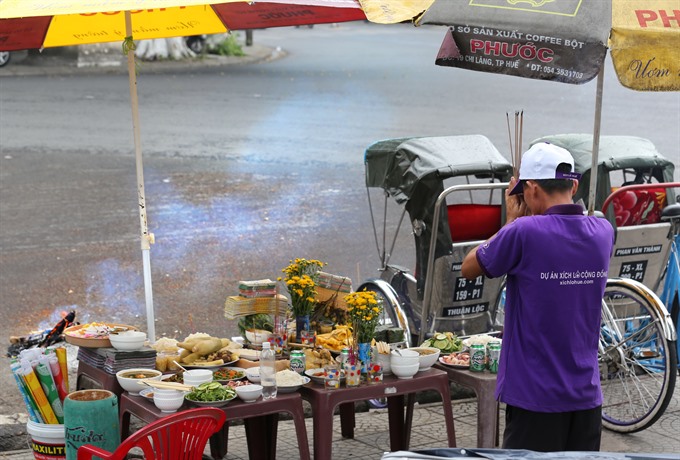 Life & Style
Life & Style

Residents of the former imperial city of Huế will light incense and offer food this week to remember the victims of a French massacre in 1885.
 |
| Sacred rites: A ceremony for remembering the “May 23 incident” victims conducted by a group of xích lô (pedicab) drivers. VNS Photo Nguyễn Văn Sum |
THỪA THIÊN-HUẾ — Residents of the former imperial city of Huế will light incense and offer food this week to remember the victims of a French massacre in 1885.
Almost every home, private business facility and public office hold ritual ceremonies for the memorials of Huế residents who died on the day the citadel of the Nguyễn Dynasty (1802-1945) fell into the hands of French colonists.
There are also ceremonies held at the community level within alleys, communal houses and holy temples.
In 1885, around 1,200 people were killed after French troops attacked the former capital. The date was May 23 in the lunar calendar, so local residents recall it as the “May 23 incident” or “the day of the capital falling”.
From May 23 to May 30, residents conduct outdoor ceremonies not only for family members but also people who died outside their homes during the incident and became “wandering souls”.
As part of the Vietnamese tradition of offering food to the death altars on memorial days, Huế residents offer various types of food for the incident’s victims, including rice, pork, chicken, cassava, sweet potato and whatever they could afford.
A small fire is set to keep warm those who fell into rivers and canals during the incident.
Researchers said the ceremony of remembering the victims is the only one that occupies the whole city; no one regards it as a superstitious activity.
They also view the ceremony as evidence of the profound humanity of Huế residents.
There are two temples built for the victims in the city. One was built inside the citadel by King Thành Thái (1889-1907) in 1894, nine years after the incident. Today the Huế Monuments Conservation Centre, a local governmental body that manages all relics built by the dynasty in Huế, supervises the temple.
Another was built behind and outside the imperial palace by local residents. Today locals hold a grand ritual ceremony each year to memorialise the victims.
Both the temples have been restored recently. The one built by the king was conserved following recognition by local authorities as a heritage relic in 2013. The resident-built temple received facelift one year later thanks to contributions by locals. — VNS


.jpg)






